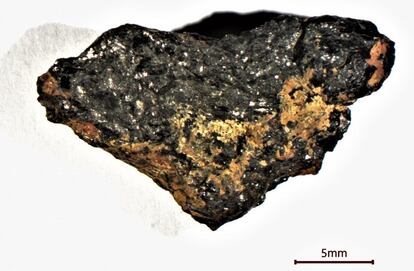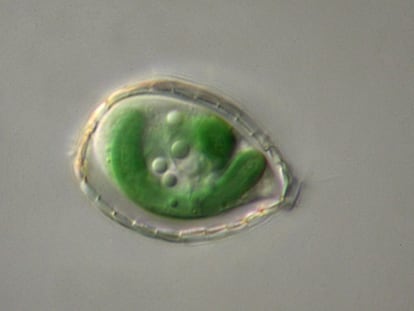A stone found in Egypt in 1996 could be first evidence of rare supernova explosion
A group of scientists in South Africa believes the ‘Hypatia stone,’ a strange extraterrestrial rock discovered in the Sahara Desert, was formed by one of the most powerful and luminous events in the universe

One December morning in 1996, shortly after the dawn prayer, Egyptian geologist Aly Barakat stumbled across a strange carbonaceous rock – black, embedded with diamonds, weighing about 30 grams – in the desert of southwestern Egypt. At first, Barakat thought it was a strange specimen of Libyan desert glass, an enigmatic yellow-colored rock common in that part of the Sahara. But he quickly realized that the object he held in his hands was something even more extraordinary.
“I picked it up, but could tell right away that it wasn’t a tektite [a natural glass object formed from terrestrial debris melted by meteorite impact]. It was something unusual, unlike anything I’d ever seen, so I kept it,” Barakat tells EL PAÍS. “And every now and then, I’d inspect it to try and determine its nature. Contrary to what researchers were claiming at the time, I knew there were signs of a massive celestial body having impacted that area, which is what caused the formation of the Libyan glass. It happened such a long time ago – about 28 million years ago – so it would be hard to detect its effects on the geology of the area,” Barakat recalls thinking at the time.
In the years that followed, Barakat continued to study the stone. Finding little support for his efforts in Egypt, and with limited outside resources at his disposal, he was forced to fund his own travel to laboratories in South Africa where he could analyze the object in more detail. It was there that Barakat discovered the stone’s extraterrestrial origins. After publishing a book on his findings in 2012, he decided to pass the baton to a new group of researchers.
In 2013, the scientists that had taken up Barakat’s research confirmed that the stone was indeed extraterrestrial in origin, and would later posit that it had been part of a much larger parent object, several meters in diameter, whose entry into the Earth’s atmosphere would have produced an extremely bright explosion of light. They also found characteristics typical of chondrites, or rocky chunks of meteorite that never experienced melting or other modifications from their original extraterrestrial form. In honor of these and other exceptional qualities, the scientists decided to name the stone Hypatia, after the philosopher and scientist who lived in the Egyptian port city of Alexandria during the Roman Empire.

Now, a new analysis of Hypatia conducted in South Africa has rekindled interest in this singular stone. In an effort to determine its origins, researchers have confirmed with an even greater degree of certainty that its pattern of elemental chemical concentration is unlike anything ever before observed in a natural object, terrestrial or extraterrestrial. The team of researchers also found additional evidence indicating that Hypatia formed sometime prior to the birth of the Solar System. And for the first time, the researchers have posited a theory to explain the process that created it: the most likely scenario, they say, is that Hypatia emerged from one of the largest and most luminous types of supernova events in the universe. This hypothesis, if confirmed, would make Hypatia the first and only physical evidence of the phenomenon ever encountered on Earth.
A supernova is a massive explosion that occurs when certain stars enter their end stage of life. The stellar event that researchers believe may have produced the Hypatia stone is known as a “type Ia” supernova. These are events that occur in binary stellar systems where two stars orbit each other, united by the force of gravity, and in which one star is a white dwarf.
The glossy, grayish-black Hypatia stone has bimodal, carbonaceous matrices, with one matrix almost entirely devoid of any elements heavier than oxygen, and the second featuring a more complex compositional pattern. In research published in the journal Icarus, the team of scientists in South Africa employed ultra-sensitive X-ray emission analysis to obtain data from the second matrix, which they then used to find clues that might help determine the rock’s origin.
Researchers detected 15 different chemical elements, noting that Hypatia’s second matrix is characterized by, among other things, its lack of silicon and manganese relative to its abundance of iron, when compared to other carbonaceous chondrites. The stone also differs from other types of rare meteorites, such as the primitive and metallic ones formed during the early phases of the Solar System, in that it contains a much higher proportion of carbon and has a different ratio of silicon to iron. At the very least, the results indicate that Hypatia’s pattern of elemental chemical concentration is unlike anything previously observed.
“The main evidence that the stone is the result of a supernova explosion is in the second matrix, where we identified 15 [chemical] elements. The only way we were able to deduce this was by looking at the chemical [composition] of that matrix,” explains Georgy Belyanin, a geologist at the University of Johannesburg, and a co-author of the study.
With these new pieces now in their hands, the researchers set out to complete the puzzle of Hypatia’s origin, and to determine how it ended up in the Egyptian desert. Starting from the assumption that the stone was originally part of a larger object that at some point experienced an impact – as evidenced by Hypatia’s high abundance of microdiamonds – researchers first considered whether the force of the impact itself might account for the rock’s unique chemical composition. But due to the precise nature of its composition, they determined that Hypatia could not have formed inside the gas cloud surrounding the Solar System, nor from the dust of interstellar space.
There was, however, a more plausible explanation that might explain the stone’s anomalous chemical composition: a supernova explosion. Specifically, a type Ia supernova. These rare and chaotic events involve the dispersion of white dwarf star matter and other byproducts from the explosion across interstellar space, and are known for unleashing primarily iron-based derivatives, which are also what make up much of Hypatia’s second matrix.
Belyanin’s team believes that the most probable scenario is that Hypatia was once part of an object created outside of the nebula that formed the Solar System, but then it entered the nebula at some point during its initial phase of formation and got trapped there. The fragments of a parent body that formed within the solar nebula, or that was already present, would have been much more likely to have made impact with a planet – Earth, for example – than with objects in interstellar space.
“Even if it had entered [after], the chances of it colliding with Earth would have been really slim, because of all the different orbits. If it entered the solar system after its formation, it would have been just another object flying around,” Belyanin says.
The researchers emphasize, however, that the mysterious case of the Hypatia stone is still an open investigation: six chemical elements in its second matrix do not correspond to models of a type Ia supernova. In other words, if the object was created by an event of this sort, other special conditions would have had to exist as well. Determining what those might be and closing the gaps in the current theory will require more research, scientists say.
Tu suscripción se está usando en otro dispositivo
¿Quieres añadir otro usuario a tu suscripción?
Si continúas leyendo en este dispositivo, no se podrá leer en el otro.
FlechaTu suscripción se está usando en otro dispositivo y solo puedes acceder a EL PAÍS desde un dispositivo a la vez.
Si quieres compartir tu cuenta, cambia tu suscripción a la modalidad Premium, así podrás añadir otro usuario. Cada uno accederá con su propia cuenta de email, lo que os permitirá personalizar vuestra experiencia en EL PAÍS.
¿Tienes una suscripción de empresa? Accede aquí para contratar más cuentas.
En el caso de no saber quién está usando tu cuenta, te recomendamos cambiar tu contraseña aquí.
Si decides continuar compartiendo tu cuenta, este mensaje se mostrará en tu dispositivo y en el de la otra persona que está usando tu cuenta de forma indefinida, afectando a tu experiencia de lectura. Puedes consultar aquí los términos y condiciones de la suscripción digital.
More information
Últimas noticias
The complicated life of Francesca Albanese: A rising figure in Italy but barred from every bank by Trump’s sanctions
Pinochet’s victims grapple with José Antonio Kast’s rise in Chile
Reinhard Genzel, Nobel laureate in physics: ‘One-minute videos will never give you the truth’
How Japan is trying to avert ‘digital defeat’
Most viewed
- Pablo Escobar’s hippos: A serious environmental problem, 40 years on
- Reinhard Genzel, Nobel laureate in physics: ‘One-minute videos will never give you the truth’
- Why we lost the habit of sleeping in two segments and how that changed our sense of time
- Charles Dubouloz, mountaineering star, retires at 36 with a farewell tour inspired by Walter Bonatti
- The Florida Keys tourist paradise is besieged by immigration agents: ‘We’ve never seen anything like this’











































